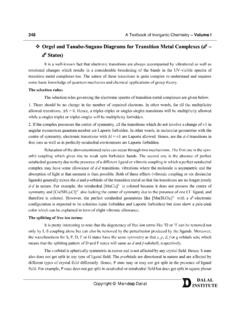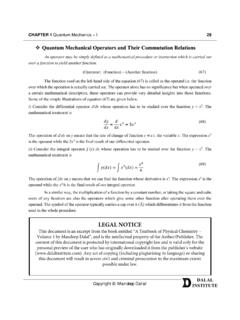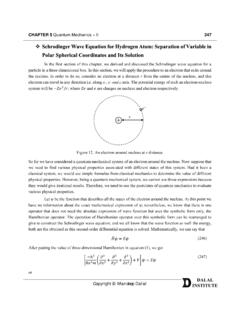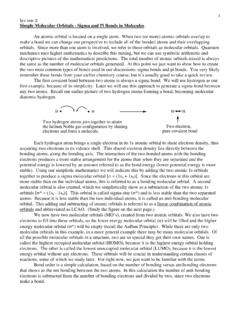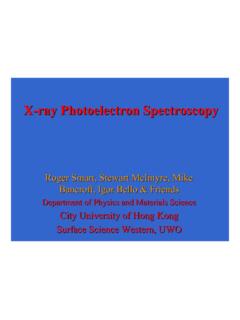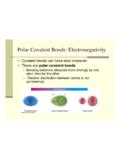Transcription of Molecular Orbital Theory – Octahedral, Tetrahedral or ...
1 184 A Textbook of Inorganic Chemistry Volume I Copyright Mandeep Dalal Molecular Orbital Theory Octahedral, Tetrahedral or Square PlanarComplexesThe crystal field Theory fails to explain many physical properties of the transition metal complexes because it does not consider the interaction between the metal and ligand orbitals . The Molecular Orbital Theory can be very well applied to transition metal complexes to rationalize the covalent as well as the ionic character in the metal-ligand bond. A transition metal ion has nine valence atomic orbitals which are consisted of five nd, three (n+1)p, and one (n+1)s orbitals . These orbitals are of appropriate energy to form bonding interaction with ligands.
2 The Molecular Orbital Theory is highly dependent on the geometry of the complex and can successfully be used for describing octahedral complexes, Tetrahedral and square-planar complexes. The main features of Molecular Orbital Theory for metal complexes are as follows: 1. The atomic Orbital of the metal center and of surrounding ligands combine to form new orbitals , known asmolecular orbitals . 2. The number of Molecular orbitals formed is the same as that of the number of atomic orbitals The additive overlap results in the bonding Molecular Orbital while the subtractive overlap results in theantibonding overlap. 4. The energy of bonding Molecular orbitals is lower than their nonbonding counterparts while the energy ofantibonding Molecular orbitals is higher than that of nonbonding orbitals .
3 5. The energy of nonbonding orbitals remains the The ionic character of the covalent bond arises from the difference in the energy of combining If the energy of a Molecular Orbital is comparable to an atomic Orbital , it will not be very much different innature from atomic Orbital . The polarity of the bond can be explained by considering the overlap of two atomic orbitals of different energies. Suppose A and B are two atomic orbitals of atoms A and B, respectively. These two atomic orbitals have one electron in each of them and combine to form one bonding ( ) and one antibonding ( *) Molecular Orbital . After the formation of Molecular orbitals , both electrons occupy - Orbital .
4 Now, if the energy of - Orbital is closer to A, it will have more A character and hence the electron density of both of the electrons will be concentrated more on atom A than B. Similarly if the energy of - Orbital is closer to B, it will have more B character and the electron density of both of the electrons will be concentrated more on atom B than A. This same explanation holds for the ionic character in metal-ligand bond. The main concern here is that the total number of the Molecular orbitals formed as a result of bonding and antibonding interactions is quite large; and therefore, many complications related to the understanding of symmetry-energy may arise, all of which needs a very sophisticated treatment of chemical bonding.
5 Hence, without a comprehensive knowledge of the chemical applications of group Theory , it is quite difficult to explain the whole concept. However, a primitive explanation for the -bonding in transition metal complexes of different geometry can still be given. CHAPTER 7 Metal-Ligand Bonding: 185 Copyright Mandeep Dalal Octahedral Complexes In octahedral complexes, the Molecular orbitals created by the coordination of metal center can be seen as resulting from the donation of two electrons by each of six -donor ligands to the d- orbitals on the metal. The metal orbitals taking part in this type of bonding are nd, (n+1)p and (n+1)s.
6 It should be noted down that not all nd- orbitals but only dz2 and dx2 y2 orbitals are capable of participating in the -overlap. The dxy, dxz and dyz orbitals remain non-bonding orbitals . The ligands approach the metal center along the x, y and z-axes in such a way that their -symmetry orbitals form bonding and anti-bonding combinations with metal s s, px, py, pz, dz2 and dx2 y2 orbitals . A total of six bonding and six anti-bonding Molecular orbitals formed. The symmetry designations of different metal orbitals taking part in octahedral overlap are: dz2, dx2 y2 eg s a1g px, py, pz t1u dxy, dxz, dyz t2g The exact nature of the Mulliken symbols, like eg or a1g, etc.
7 , can be understood only after the core level understanding of group Theory . However, it still can be noted that a, e and t represents singly, doubly and triply degenerate orbitals , respectively. The subscripts g and u represent gerade and ungerade nature of the orbitals . An Orbital is said to be gerade if it has the same sign in all opposite directions from the center. These are also said to be having the centre of symmetry. On the other hand, an Orbital is said to be ungerade if it has the opposite sign in all the opposite directions from the center. These are also said to be lacking the centre of symmetry. The symmetry adapted linear combinations of atomic orbitals (SALCs) for metal-ligand direct overlap can be obtained just by resolving the reducible representation based on the bond vectors along the axis of -overlap.
8 As there are total six bond vectors for the metal-ligand -bonding, hexa-dimensional reducible representation will be obtained. As the six ligands in an octahedral complex approach the central metal ion along the three Cartesian axes (two along x-axis, two along y-axis and two along z-axis), the six -basis bond vectors must also be selected along x, y and z-axis. Figure 3. Continued on the next Buy the complete book with TOC navigation, high resolution images and no A Textbook of Inorganic Chemistry Volume I Copyright Mandeep Dalal Figure 3. The octahedral coordination and corresponding -basis set for ligand orbitals in octahedral complexes.
9 The symmetry adapted linear combinations of these fall into three irreducible representations labeled as a1g, eg, and t1u. The symmetry designations of different ligand orbitals taking part in octahedral overlap are: Table 1. Reducible representation based on bond vectors in the octahedral geometry. Oh E 8C3 6C2 6C4 3C2 i 6S4 8S6 3 h 6 d Irreducible components 6 0 0 2 2 0 0 0 4 2 a1g + eg + t1u The metal- Orbital sets of a1g, eg and t1u symmetry participate in -bonding by interacting with the same symmetry SALCs sets to produce -bonding and antibonding Molecular orbitals . However, the triply degenerate t2g orbitals set on the metal remains nonbonding as there no ligand orbitals of this symmetry.
10 The exact nature of the symmetry adapted linear combination of atomic orbitals or simply SALCs is quite complex and is beyond the scope of this volume but still we can simply give a superficial explanation for these ligand orbitals . The pictorial representation of various SALC orbitals in octahedral complexes, capable of -overlap with metal orbitals , can be given as: 1. If the six atomic orbitals of six ligands are pointing their positive lobes towards metal s s- Orbital , then the composite Orbital becomes: 1 = 1 + 2 + 3 + 4 + 5 + 6 (1) The pictorial representation is given below. Buy the complete book with TOC navigation, high resolution images and no 7 Metal-Ligand Bonding: 187 Copyright Mandeep Dalal Figure 4.

